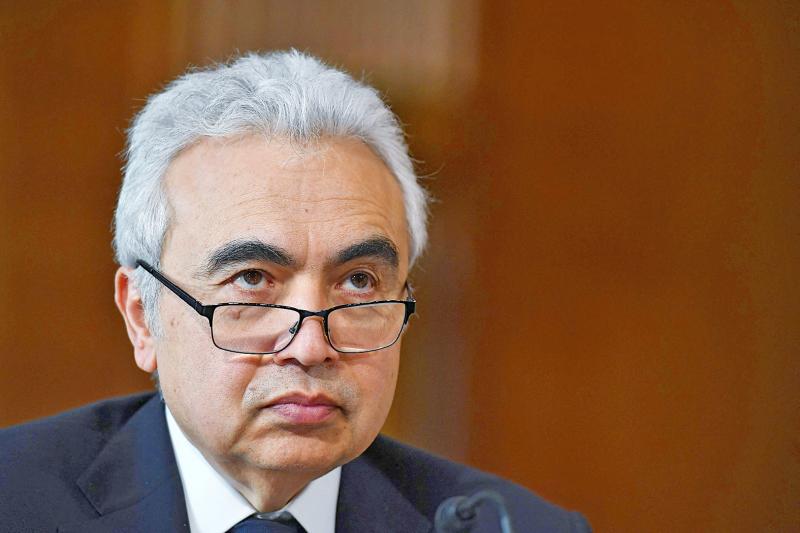A global transition to “clean energy” is still far too slow to meet climate pledges and risks fueling even greater price volatility, the International Energy Agency (IEA) said yesterday.
“We are not investing enough to meet future energy needs and the uncertainties are setting the stage for a volatile period ahead,” IEA executive director Fatih Birol said. “The social and economic benefits of accelerating clean energy transitions are huge, and the costs of inaction are immense.”
In its annual World Energy Outlook report — published just weeks before the COP26 summit in Glasgow, Scotland — the IEA said that investment in clean energy projects and infrastructure would need to be more than trebled over the next decade if those pledges are to be met.

Photo: CNA
The IEA said that renewable sources such as wind and solar energy continued to grow rapidly, and electric vehicles set new sales records last year, even as economies were bent under the weight of COVID-19 lockdowns.
However, “this clean energy progress is still far too slow to put global emissions into sustained decline towards net zero” by 2050,” it said.
The agency analyzed two possible scenarios.
The first looked at the measures governments had already put in place or specific policies they were developing.
Under this scenario, temperatures in 2100 would be 2.6°C higher than pre-industrial levels, it said.
The second looked at promises made by some governments to achieve net-zero emissions, which would see a doubling of clean energy investment and financing over the next decade.
If these pledges were fully implemented in time, global carbon emissions fall by 40 percent by 2050, the IEA said.
Here, the global average temperature increase in 2100 would be about 2.1°C, which would represent an improvement, but would still be way above the 1.5°C agreed under the Paris Agreement, it said.

AIR SUPPORT: The Ministry of National Defense thanked the US for the delivery, adding that it was an indicator of the White House’s commitment to the Taiwan Relations Act Deputy Minister of National Defense Po Horng-huei (柏鴻輝) and Representative to the US Alexander Yui on Friday attended a delivery ceremony for the first of Taiwan’s long-awaited 66 F-16C/D Block 70 jets at a Lockheed Martin Corp factory in Greenville, South Carolina. “We are so proud to be the global home of the F-16 and to support Taiwan’s air defense capabilities,” US Representative William Timmons wrote on X, alongside a photograph of Taiwanese and US officials at the event. The F-16C/D Block 70 jets Taiwan ordered have the same capabilities as aircraft that had been upgraded to F-16Vs. The batch of Lockheed Martin

GRIDLOCK: The National Fire Agency’s Special Search and Rescue team is on standby to travel to the countries to help out with the rescue effort A powerful earthquake rocked Myanmar and neighboring Thailand yesterday, killing at least three people in Bangkok and burying dozens when a high-rise building under construction collapsed. Footage shared on social media from Myanmar’s second-largest city showed widespread destruction, raising fears that many were trapped under the rubble or killed. The magnitude 7.7 earthquake, with an epicenter near Mandalay in Myanmar, struck at midday and was followed by a strong magnitude 6.4 aftershock. The extent of death, injury and destruction — especially in Myanmar, which is embroiled in a civil war and where information is tightly controlled at the best of times —

China's military today said it began joint army, navy and rocket force exercises around Taiwan to "serve as a stern warning and powerful deterrent against Taiwanese independence," calling President William Lai (賴清德) a "parasite." The exercises come after Lai called Beijing a "foreign hostile force" last month. More than 10 Chinese military ships approached close to Taiwan's 24 nautical mile (44.4km) contiguous zone this morning and Taiwan sent its own warships to respond, two senior Taiwanese officials said. Taiwan has not yet detected any live fire by the Chinese military so far, one of the officials said. The drills took place after US Secretary

THUGGISH BEHAVIOR: Encouraging people to report independence supporters is another intimidation tactic that threatens cross-strait peace, the state department said China setting up an online system for reporting “Taiwanese independence” advocates is an “irresponsible and reprehensible” act, a US government spokesperson said on Friday. “China’s call for private individuals to report on alleged ‘persecution or suppression’ by supposed ‘Taiwan independence henchmen and accomplices’ is irresponsible and reprehensible,” an unnamed US Department of State spokesperson told the Central News Agency in an e-mail. The move is part of Beijing’s “intimidation campaign” against Taiwan and its supporters, and is “threatening free speech around the world, destabilizing the Indo-Pacific region, and deliberately eroding the cross-strait status quo,” the spokesperson said. The Chinese Communist Party’s “threats